Reviews
With ‘Like Life,’ the Met Breuer Has Arrived at Something New, Paradoxical, and Strangely of Its Time
New York's encyclopedic museum stakes its contemporary-art fortunes on courting a new kind of taste.
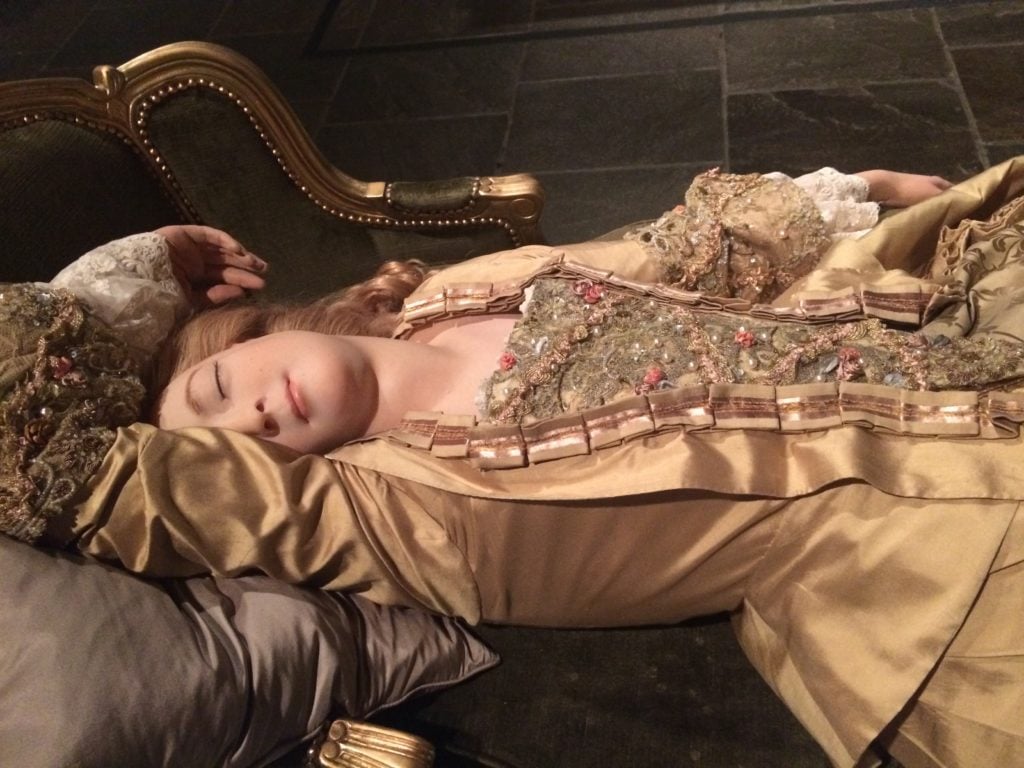
New York's encyclopedic museum stakes its contemporary-art fortunes on courting a new kind of taste.

Ben Davis

The big question about the Met Breuer’s big “Like Life” show is… what is it, exactly? How should we view this blowout highbrow creep-show exhibition? Why is it?
The show began, or so co-curator Luke Syson said at the press launch, with the working title “Polychrome,” and was initially meant to explore the tradition of painted or otherwise colored sculpture in European art. But under the mandate of (other) co-curator Sheena Wagstaff—the head of the museum’s Modern and contemporary art department, and the de-facto tzar of the Met Breuer—to further blaze the trail of “transhistorical exhibitions” set down by the institution’s debut “Unfinished” show of a few years ago, it became something else: less straight-forwardly historical, more freewheeling and daring; more populist, but also probably more disorienting.
So, if you are asking yourself, “Is there a place in New York, right now, where I can see a mannequin with a lifelike replica of the artist’s penis attached?” (Charles Ray’s Male Mannequin, 1990) or “How can I get a peek at a chalice that evokes Marie Antoinette’s breast?” (a fine porcelain “Breast Bowl,” attributed to Jean-Jacques Lagrenée, 1787-88)—well, the Met has created this lavishly produced show for you!
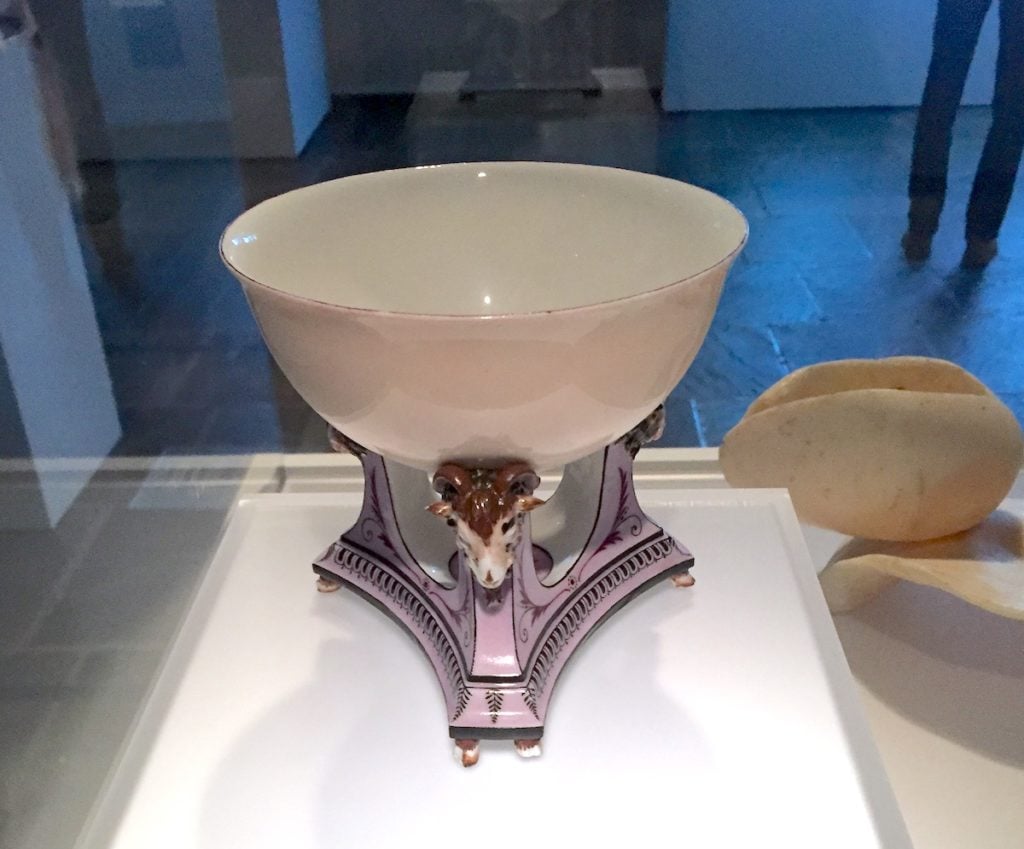
Sevres Manufactory, design attributed to Jean-Jacques Lagrenée (1787-88). Image courtesy Ben Davis.
And you know what? It’s cool. And weird. And challenging. It’s just a heck of a show, with 120 art objects and art-like objects, many of them major loans and many of them things you probably didn’t even know you wanted to see, let alone to see together.
At its heart, “Like Life” is an admirable attempt to solve the riddle of how the Met can do contemporary art in a credibly Met-y way. A mix-and-match curating style of evocative historical objects and on-trend contemporary art has been a staple of biennials for years now. But at such events, it often it feels as if the device is meant to steal a little gravity for light-weight contemporary art by importing it from art history. Here, it feels as if the reverse is happening. The Met is projecting a specific contemporary interest in “the body” backwards through time, setting the curatorial kaleidoscope on hyperrealism, and reveling in the resulting pattern it brings out in art history.

Doll in a Box (ca. 1748). Image courtesy Ben Davis.
In place of chronology, there are thematic chapters where blocs of art riff on catchalls: “Likeness,” “Desire for Life,” “Proxy Figures,” “Layered Realities,” “Figuring Flesh,” and “Between Life and Art.” Probably the most conventionally educational is the introductory one, “The Presumption of White,” which takes off from the well-known point that most Renaissance and European neoclassical sculpture is based on a misreading of antiquity as austere and snowy in complexion, when actually it was painted.
The removal of color served to place sculptural form in an ideal and idealizing formal space, away from the earthier realism of painted sculpture. At the same time, Greek sculpture’s arcane chromatic exuberance was probably not merely naturalistic, but deliberately ostentatious. It was meant to be eye-catching, lavish, to make sculpture that shouted loud enough to read to a big audience. Giant-sized multicolored statues of gods studded with semi-precious metals were meant to provoke wonder in their audience.
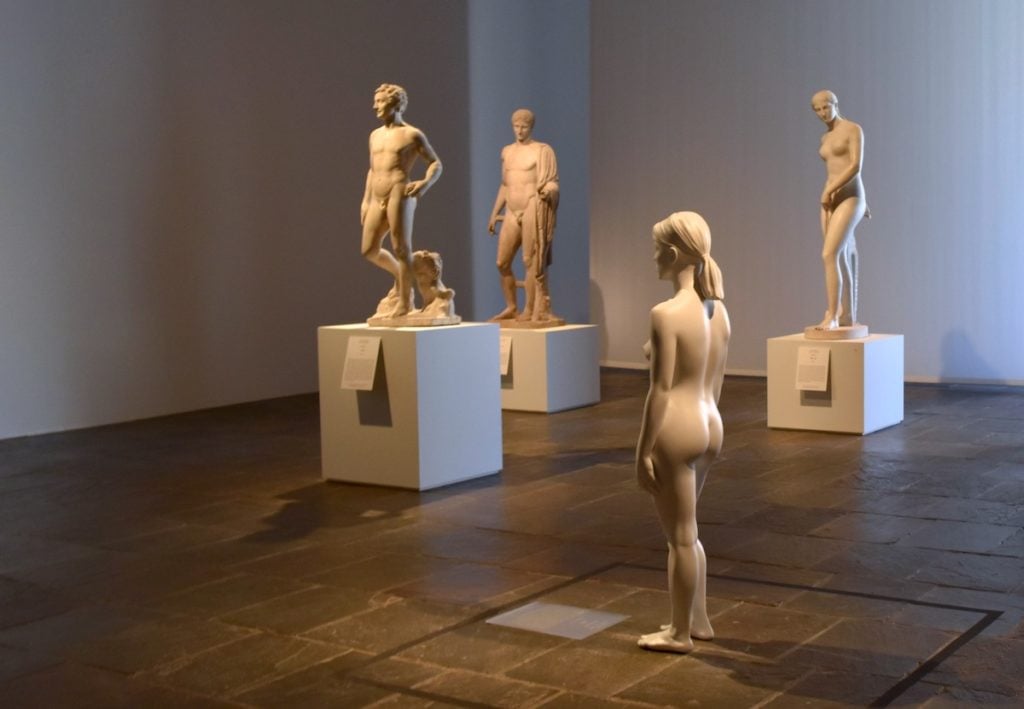
Installation view of the “Presumption of White” section of “Like Life” at the Met Breuer. Image courtesy Ben Davis.
When you come right down to it, it is the populism more than the realism that forms the ground note in “Like Life,” which has a slightly carnivalesque feeling to it, albeit one held in suspension with the Met’s low-lit reverence. As Peter Schjeldahl quipped of the premise of “Like Life,“ the show “does maintain fairly lofty standards of quality but logically needn’t.” Syson and Wagstaff widen the aperture of art history, and the wavelengths that come in resonate with a lot of popular stuff normally masked out. Madame Tussauds’s wax figures of celebrities. Disney’s animatronic Hall of Presidents. Creepy doll collections. Anatomical dummies. Religious reliquaries, with their chunks of bone, teeth, and hair.
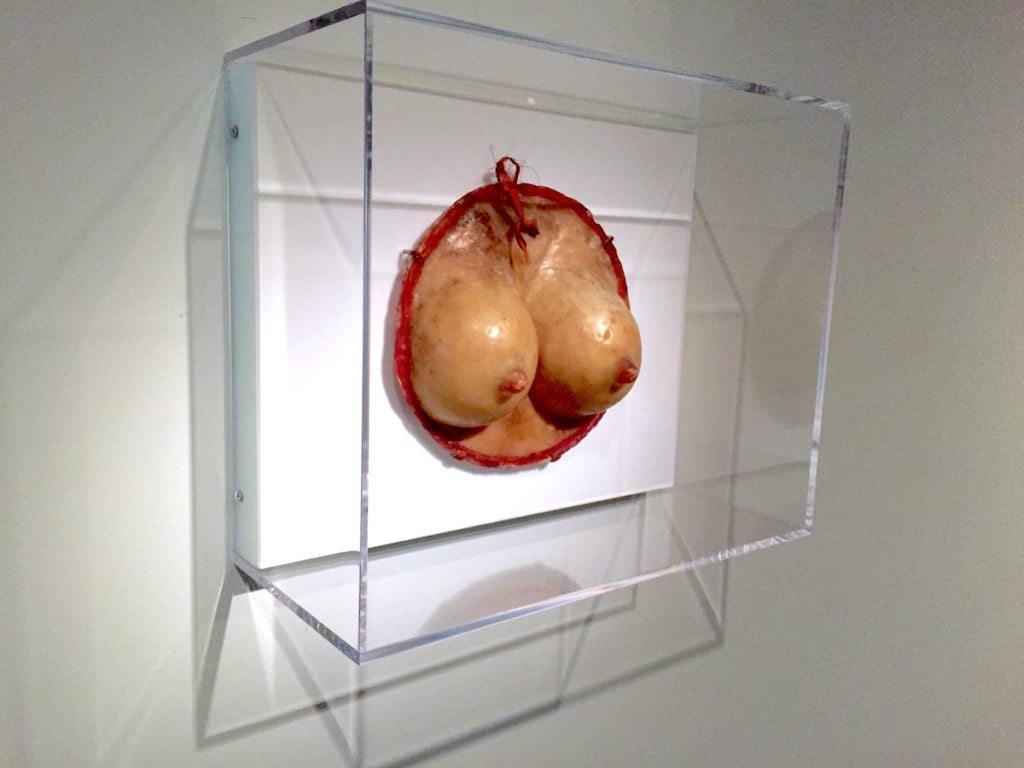
Ex-Voto Breasts (late-19th-early 20th century). Image courtesy Ben Davis.
Put another way, you can say that the new model of “transhistorical” curating that the Met has seized upon to square its encyclopedic mission with its obligation (due to manifold pressures) to catch the fire of contemporary art basically just reinvents the old Cabinet of Curiosities. That model of mixing fine art originals with didactic replicas, medical oddities, and scientific illustration was in fact the dominant mode of taste before 19th-century standards of bourgeois culture hardened the distinction between popular and elite taste, and put the accent on exposure to the ennobling aura of unique masterpieces.
A question I have is: What is lost in this re-blurring of boundaries, or smuggled back in? The Cabinet of Curiosities model predates the formal discipline of art history, with its comparative categories and attempt at drawing bright contextual lines. If you rewind the clock, you overcome some of its artificially imposed aesthetic boundaries and recover some of the thrills hidden beneath art history’s starchier linear schema; but you also return to a way of looking that is relatively decontextualizing, as the early colonial gaze that formed the Cabinet of Curiosities was.
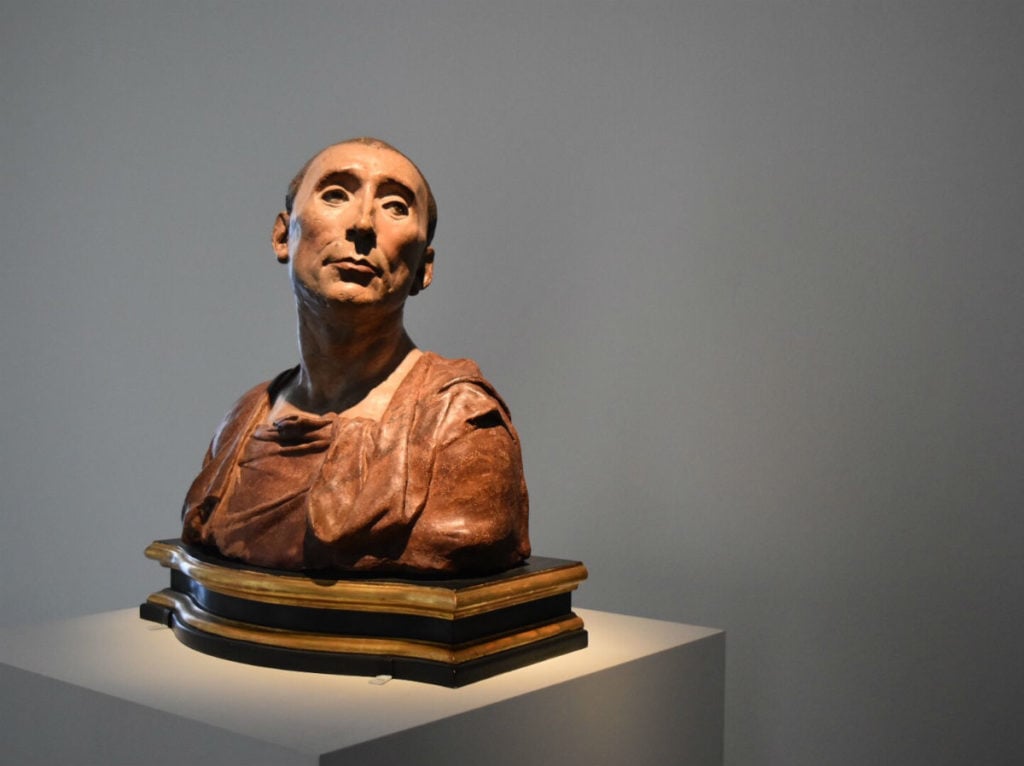
Donatello, Bust of Niccolò da Uzzano (1430s). Image courtesy Ben Davis.
Making the passage from a meticulously dignified, lifelike Donatello portrait bust (Bust of Niccolò da Uzzano, 1430s) to Marc Quinn’s mold of his own head, made with his own frozen blood kept in a refrigerated display case (Self, 1991), is one thing. The two works bring out, in one another, a sense of delirious showmanship.
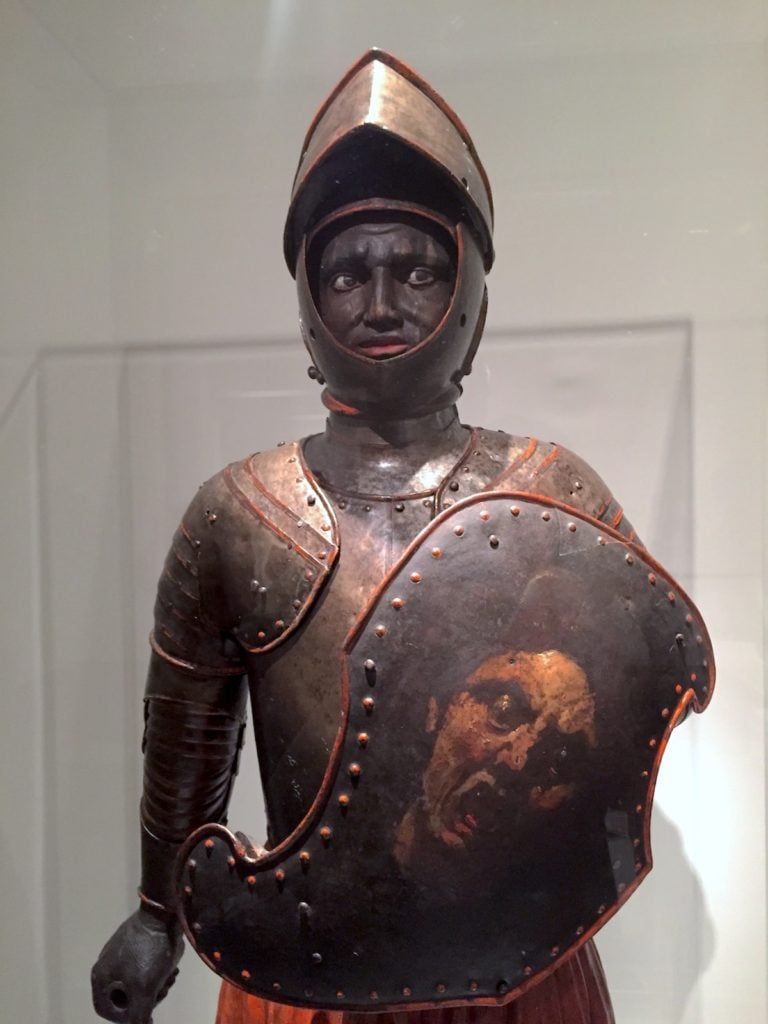
Saracen Jousting Figure (1579) in “Like Life” at the Met Breuer. Image courtesy Ben Davis.
But when you get to a life-sized wooden dummy, once used at a Medici wedding celebration and meant to serve as target practice for warriors training against Muslim Arabs and Turks (Saracen Jousting Figure, 1579) and find it positioned between Jeff Koons’s goony sculpture of Buster Keaton (1988) and Goshka Macuga’s animatronic talking robot, To the Son of Man Who Ate the Scroll (2016), well, that takes me to another place. You wonder if the “transhistorical” format doesn’t tend to become, actually, anti-historical, serving to introduce some rather vital and grave art-historical material that you’d like to see really worked through, only to diffuse it posthaste.
If the aesthetically ecumenical sensibility of “Like Life” represents a definite kind of populist appeal, on one level, on another it represents a fairly refined kind of aesthetic sensibility of its own. The core value purveyed by this show is not the Beautiful—the experience of harmonious form. Nor is it the Sublime—the artistic sensation of awe or horror. Nor is it Conceptual, since its thrills are not in the realm of ideas, but visual and even visceral (at times literally, in the sense of exposing you to actual viscera).
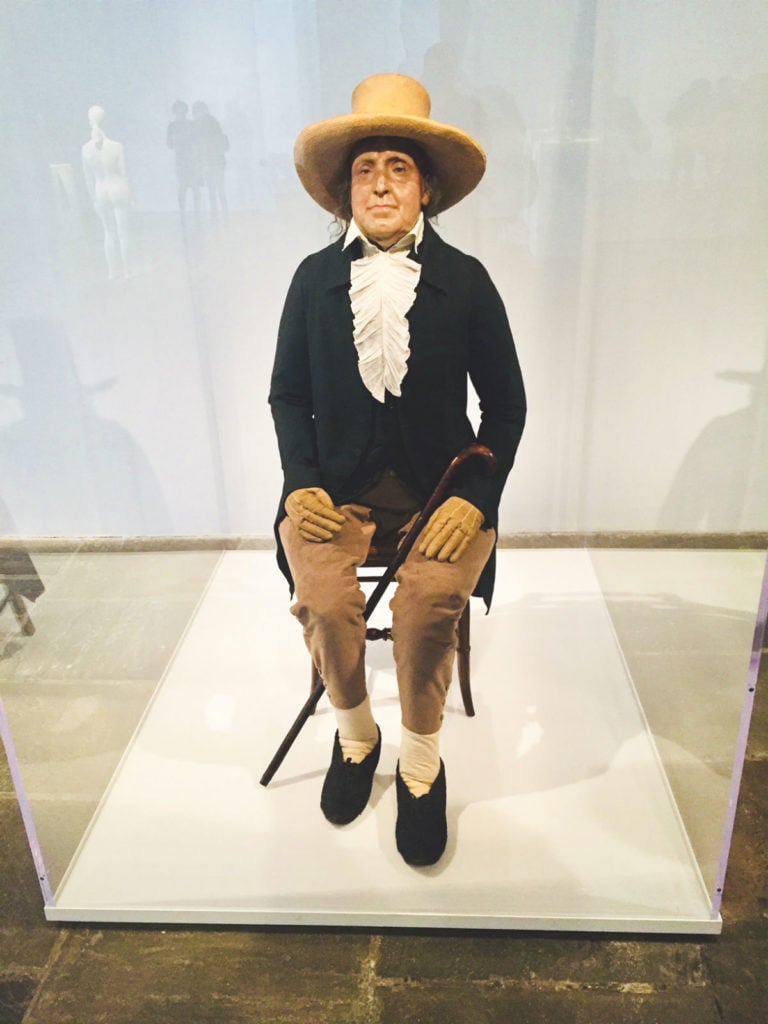
Thomas Southwood Smith and Jacques Talrich, Auto-Icon of Jeremy Bentham (1832). Image courtesy Ben Davis.
The sensibility proposed by “Like Life” is a taste for the Curious—or whatever you call the thrill you get from seeing philosopher Jeremy Bentham’s preserved corpse, propped up in a glass box. I’m trying not to use the term “hipster taste” here, because that’s too dismissive. But a command of brainy novelty, where status is accumulated less by elegance or intelligence and more by a cultivated command over edgy obscurity, is a very definite form of contemporary taste. And I suppose its arrival as a pillar of the Met’s exhibition strategy on the Upper East Side illustrates its continuity with the older form of taste-making and status-marking as well.
“Like Life: Sculpture, Color, and the Body (1300-Now)” is on view at the Met Breuer, through July 22, 2018.